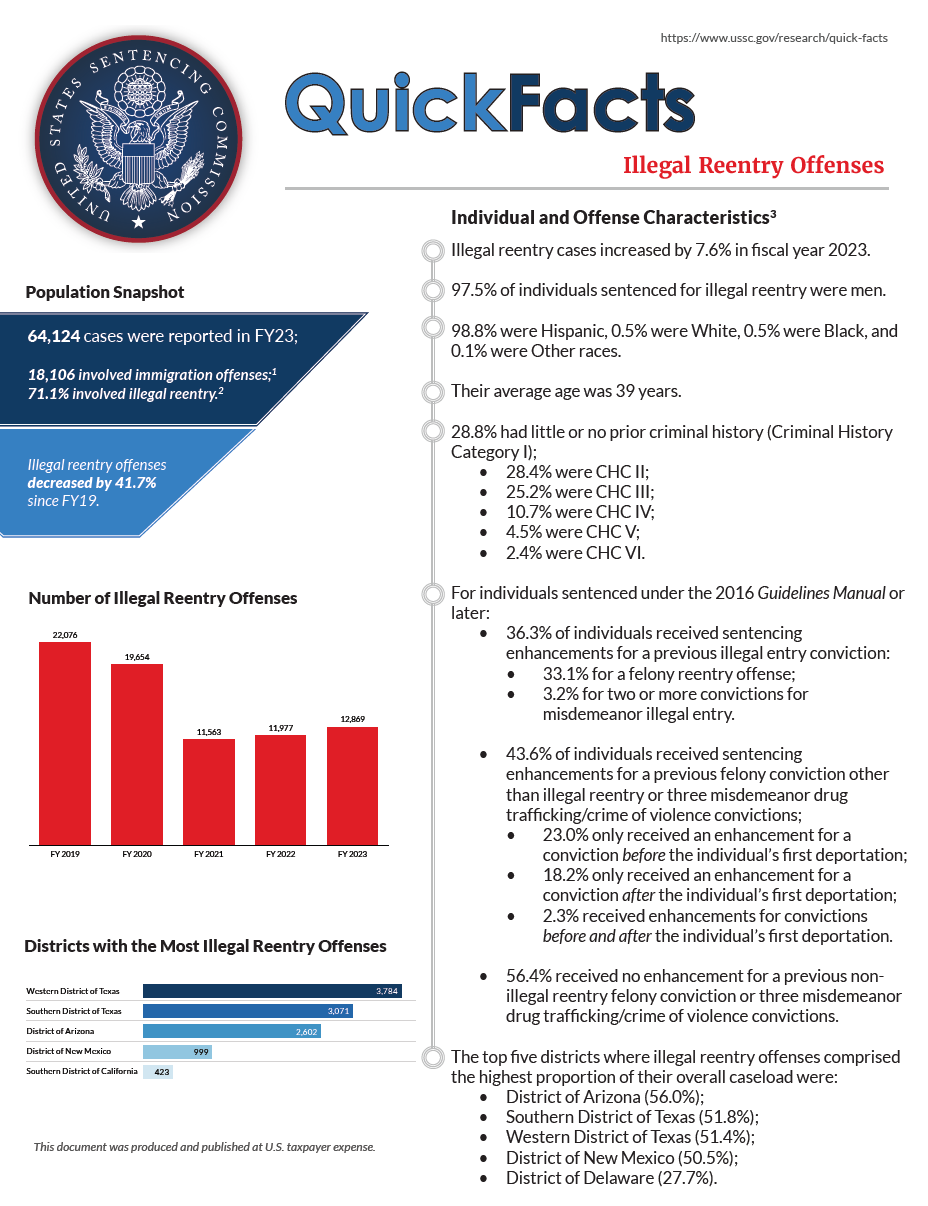Of the 61,678 cases reported to the Commission in fiscal year 2024, 17,336 involved immigration offenses.1 Of those cases, 72.4% involved illegal reentry (down 36.1% since fiscal year 2020 and 2.5% from the previous year).2,3
Click the cover for the PDF handout or learn more below.
Individual and Offense Characteristics
- 97.1% of individuals sentenced for illegal reentry were men.
- 99.0% were Hispanic, 0.5% were White, 0.5% were Black, and fewer than 0.1% were Other races.
- Their average age was 39 years.
- 33.8% had little or no prior criminal history (Criminal History Category I);
- 30.4% were CHC II;
- 22.0% were CHC III;
- 7.9% were CHC IV;
- 4.0% were CHC V;
- 1.9% were CHC VI.
- For individuals sentenced under the 2016 Guidelines Manual or later:
- 34.0% of individuals received sentencing enhancements for a previous illegal entry conviction:
- 31.6% for a felony reentry offense;
- 2.7% for two or more convictions for misdemeanor illegal entry.
- 41.6% of individuals received sentencing enhancements for a previous felony conviction other than illegal reentry or three misdemeanor drug trafficking/crime of violence convictions:
- 20.6% only received an enhancement for a conviction before the individual’s first deportation;
- 18.4% only received an enhancement for a conviction after the individual’s first deportation;
- 2.7% received enhancements for convictions before and after the individual’s first deportation.
- 58.4% received no enhancement for a previous non-illegal reentry felony conviction or three misdemeanor drug trafficking/crime of violence convictions.
- 34.0% of individuals received sentencing enhancements for a previous illegal entry conviction:
- The top five districts where illegal reentry offenses comprised the highest proportion of their overall caseload were:
- Western District of Texas (60.4%);
- District of New Mexico (53.9%);
- District of Arizona (50.9%);
- Southern District of Texas (49.8%);
- District of Delaware (28.4%).
Punishment
- The average sentence for individuals sentenced for illegal reentry was 12 months.
- 95.7% were sentenced to prison.
Sentences Relative to the Guideline Range
- 85.9% of sentences for illegal reentry were under the Guidelines Manual.
- 65.0% were within the guideline range.
- 16.7% were Early Disposition Program (EDP) departures.4
- The average sentence reduction was 41.4%.
- The average sentence reduction was 41.4%.
- 3.8% were some other downward departure.
- Their average sentence reduction was 37.1%.
- Their average sentence reduction was 37.1%.
- 65.0% were within the guideline range.
- 14.1% of sentences for illegal reentry were variances.
- 9.7% were downward variances.
- The average sentence reduction was 41.0%.
- The average sentence reduction was 41.0%.
- 4.3% were upward variances.
- The average sentence increase was 74.5%.
- 9.7% were downward variances.
- The average guideline minimum and the average sentence imposed have fluctuated over the past five years.
- The average guideline minimum increased and decreased throughout the fiscal years. The average guideline minimum was 9 months in fiscal year 2020 and 12 months in fiscal year 2024.
- The average sentence imposed increased and decreased throughout the fiscal years. The average sentence imposed was 8 months in fiscal year 2020 and 12 months in fiscal year 2024.
- The average guideline minimum increased and decreased throughout the fiscal years. The average guideline minimum was 9 months in fiscal year 2020 and 12 months in fiscal year 2024.
1 Immigration cases include cases where individuals were sentenced under USSG §§2L1.1 (Smuggling, Transporting or Harboring an Unlawful Alien), 2L1.2 (Illegal Reentry), 2L2.1 (Trafficking in Documents Relating to Citizenship), 2L2.2 (Fraudulently Acquiring Documents Relating to Citizenship), and 2L2.5 (Failure to Surrender Cancelled Naturalization Certificate).
2 Illegal reentry involves cases in which the court applied USSG §2L1.2 as the primary sentencing guideline.
3 Cases with incomplete sentencing information were excluded from the analysis.
4 “Early Disposition Program" (or EDP) departures are departures where the government sought a sentence below the guideline range because the defendant participated in the government’s Early Disposition Program, through which cases are resolved in an expedited manner. See USSG §5K3.1.
SOURCE: United States Sentencing Commission, FY 2020 through FY 2024 Datafiles, USSCFY20-USSCFY24.

